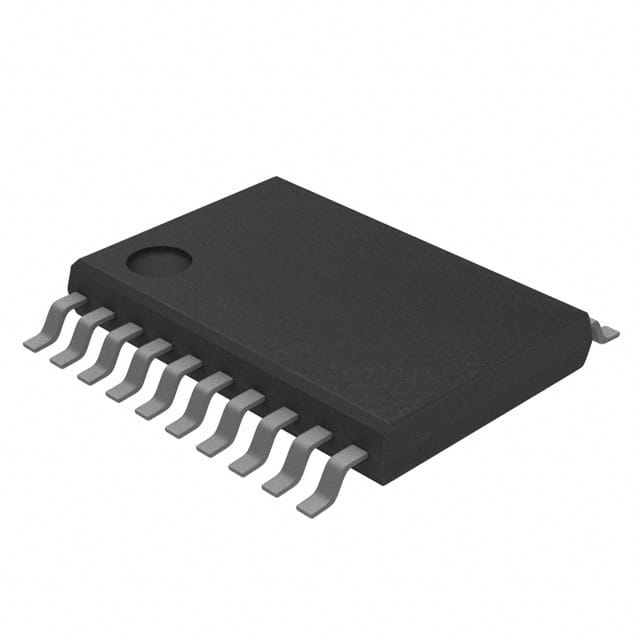Voir les spécifications pour les détails du produit.

SN74ABT623PW
Product Overview
- Category: Integrated Circuit
- Use: Bus Transceiver
- Characteristics: High-speed, Bi-directional, 8-bit transceiver
- Package: TSSOP (Thin Shrink Small Outline Package)
- Essence: Converts signals between two bidirectional buses
- Packaging/Quantity: Tape and Reel, 2500 units per reel
Specifications
- Supply Voltage Range: 4.5V to 5.5V
- Input Voltage Range: 0V to VCC
- Output Voltage Range: 0V to VCC
- Operating Temperature Range: -40°C to +85°C
- Propagation Delay Time: 3.5ns (Max)
- Output Current: ±24mA
Detailed Pin Configuration
The SN74ABT623PW has a total of 20 pins. The pin configuration is as follows:
- OE (Output Enable) - Active Low Output Enable
- A1 - Data Bus A Bit 1
- A2 - Data Bus A Bit 2
- A3 - Data Bus A Bit 3
- A4 - Data Bus A Bit 4
- A5 - Data Bus A Bit 5
- A6 - Data Bus A Bit 6
- A7 - Data Bus A Bit 7
- A8 - Data Bus A Bit 8
- GND - Ground
- B8 - Data Bus B Bit 8
- B7 - Data Bus B Bit 7
- B6 - Data Bus B Bit 6
- B5 - Data Bus B Bit 5
- B4 - Data Bus B Bit 4
- B3 - Data Bus B Bit 3
- B2 - Data Bus B Bit 2
- B1 - Data Bus B Bit 1
- VCC - Supply Voltage
- DIR (Direction) - Direction Control Input
Functional Features
- Bi-directional data transfer between two buses
- High-speed operation for efficient data transmission
- Output enable control for disabling the outputs when not required
- Direction control input to determine the data flow direction
Advantages and Disadvantages
Advantages: - High-speed operation allows for quick data transfer - Bi-directional functionality eliminates the need for separate transceivers - Output enable control provides flexibility in managing output signals
Disadvantages: - Limited voltage range of 4.5V to 5.5V may restrict compatibility with certain systems - Propagation delay time of 3.5ns may introduce slight delays in data transmission
Working Principles
The SN74ABT623PW is a bus transceiver that enables bidirectional data transfer between two buses. It operates by converting signals from one bus to another, allowing data to flow in both directions. The direction of data flow is controlled by the DIR pin. When the DIR pin is set to a logic high, data flows from Bus A to Bus B, and when it is set to a logic low, data flows from Bus B to Bus A. The OE pin can be used to disable the outputs when not required.
Detailed Application Field Plans
The SN74ABT623PW is commonly used in various applications where bidirectional data transfer between buses is required. Some of the detailed application field plans include:
- Microprocessor Systems: The transceiver facilitates communication between the microprocessor and external devices, such as memory modules or peripheral components.
- Data Communication Networks: It enables data exchange between different network nodes, ensuring smooth and efficient communication.
- Industrial Automation: The transceiver plays a vital role in connecting various control systems and devices, allowing for seamless data transfer.
- Automotive Electronics: It is used in automotive applications to enable communication between different electronic modules within the vehicle.
Detailed and Complete Alternative Models
- SN74ABT623A: Similar to SN74ABT623PW, but available in SOIC (Small Outline Integrated Circuit) package.
- SN74ABT623D: Similar to SN74ABT623PW, but available in SSOP (Shrink Small Outline Package) package.
- SN74ABT623N: Similar to SN74ABT623PW, but available in PDIP (Plastic Dual In-Line Package) package.
These alternative models offer similar functionality and characteristics as SN74ABT623PW but differ in their package options, providing flexibility based on specific application requirements.
Word count: 511 words
Énumérez 10 questions et réponses courantes liées à l'application de SN74ABT623PW dans les solutions techniques
Sure! Here are 10 common questions and answers related to the application of SN74ABT623PW:
Q: What is SN74ABT623PW? A: SN74ABT623PW is a specific type of integrated circuit (IC) commonly used in digital electronic systems for bus transceiver applications.
Q: What is the purpose of SN74ABT623PW? A: The purpose of SN74ABT623PW is to enable bidirectional data transfer between two buses or systems with different voltage levels.
Q: What voltage levels does SN74ABT623PW support? A: SN74ABT623PW supports voltage levels ranging from 4.5V to 5.5V, making it compatible with standard TTL and CMOS logic families.
Q: How many data lines can SN74ABT623PW handle? A: SN74ABT623PW can handle 8 data lines, allowing for simultaneous bidirectional transfer of data between two buses.
Q: Can SN74ABT623PW be used as a level shifter? A: Yes, SN74ABT623PW can be used as a level shifter to convert signals between different voltage domains.
Q: Does SN74ABT623PW have any built-in protection features? A: Yes, SN74ABT623PW has built-in ESD (electrostatic discharge) protection, which helps safeguard against damage during handling and operation.
Q: What is the maximum data rate supported by SN74ABT623PW? A: SN74ABT623PW can support data rates up to 100 MHz, making it suitable for high-speed digital communication applications.
Q: Can SN74ABT623PW be used in both parallel and serial communication systems? A: Yes, SN74ABT623PW can be used in both parallel and serial communication systems, depending on the specific application requirements.
Q: Does SN74ABT623PW require any external components for operation? A: SN74ABT623PW does not require any external components for basic operation. However, additional decoupling capacitors may be needed for noise reduction.
Q: Are there any specific layout considerations for using SN74ABT623PW? A: Yes, it is recommended to follow the manufacturer's guidelines for proper PCB layout, including minimizing trace lengths and providing adequate ground planes for optimal performance.
Please note that these answers are general and may vary based on specific design requirements and application scenarios.

